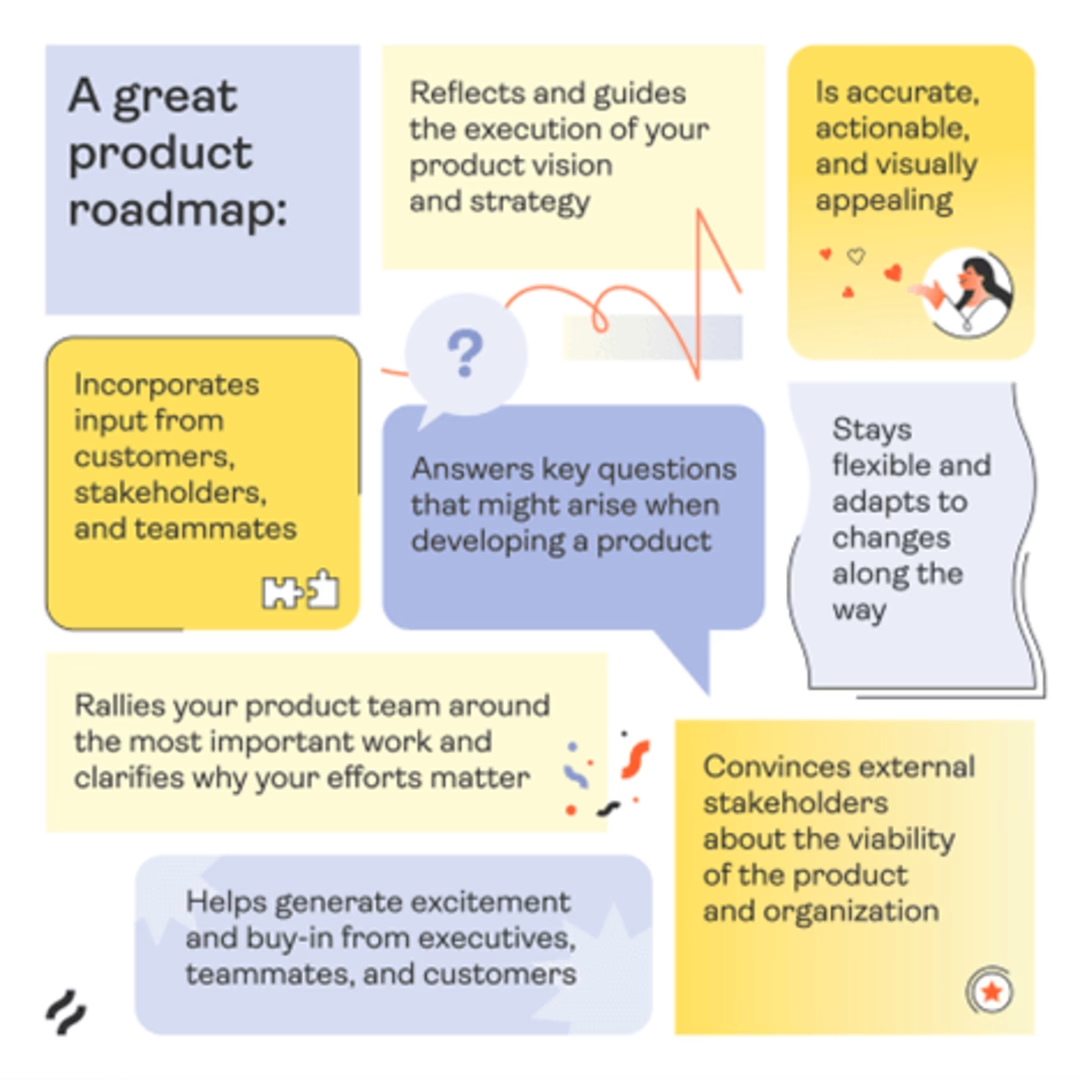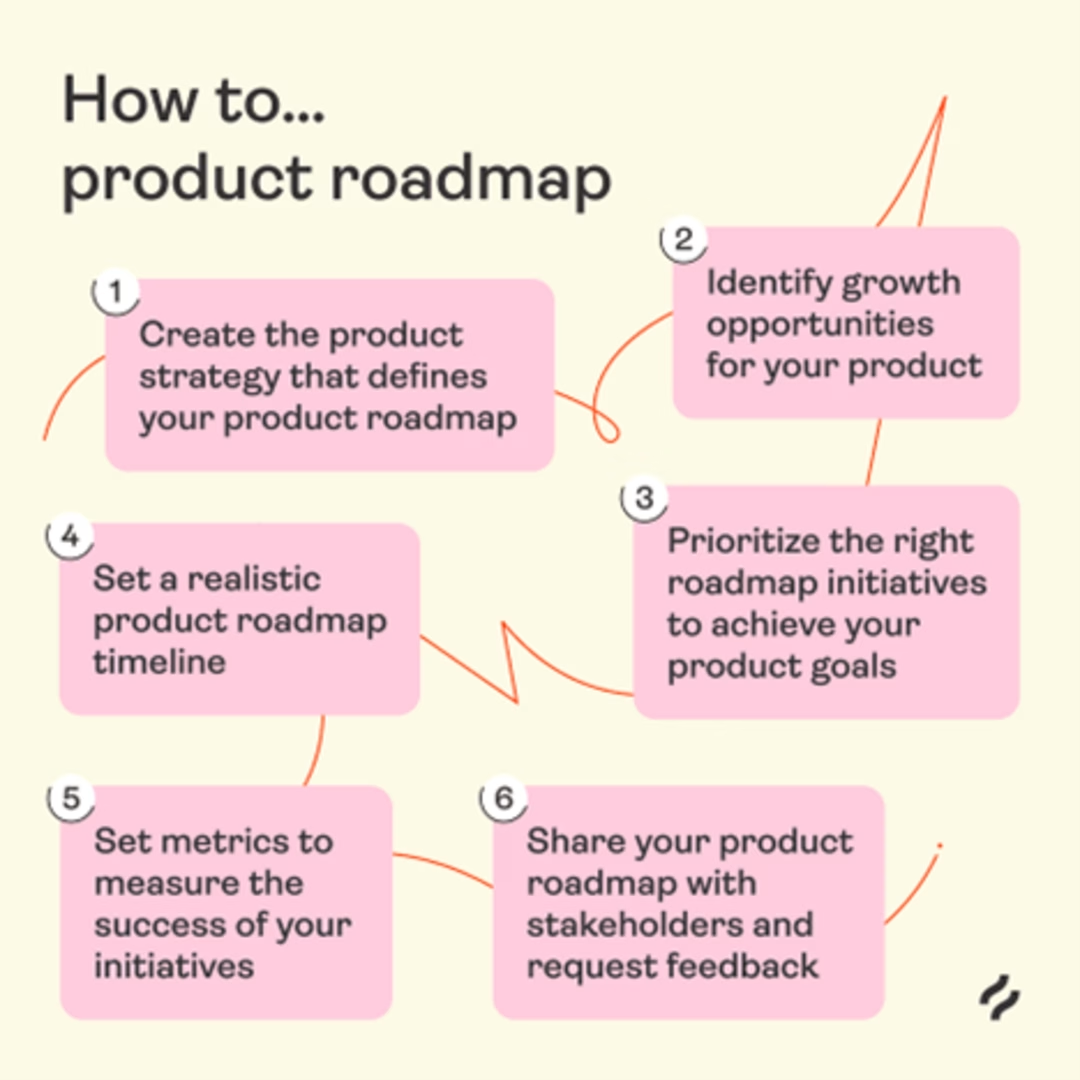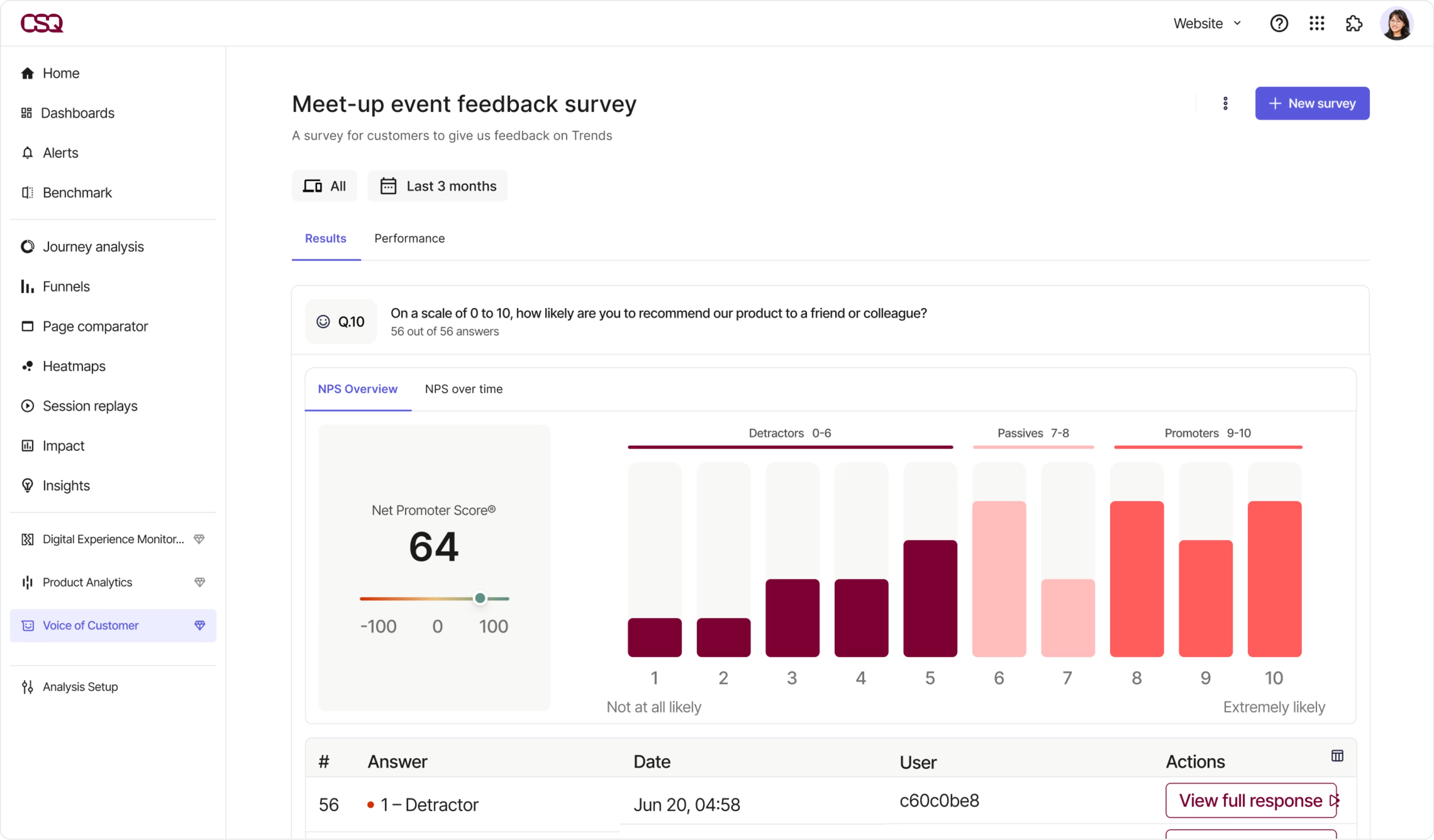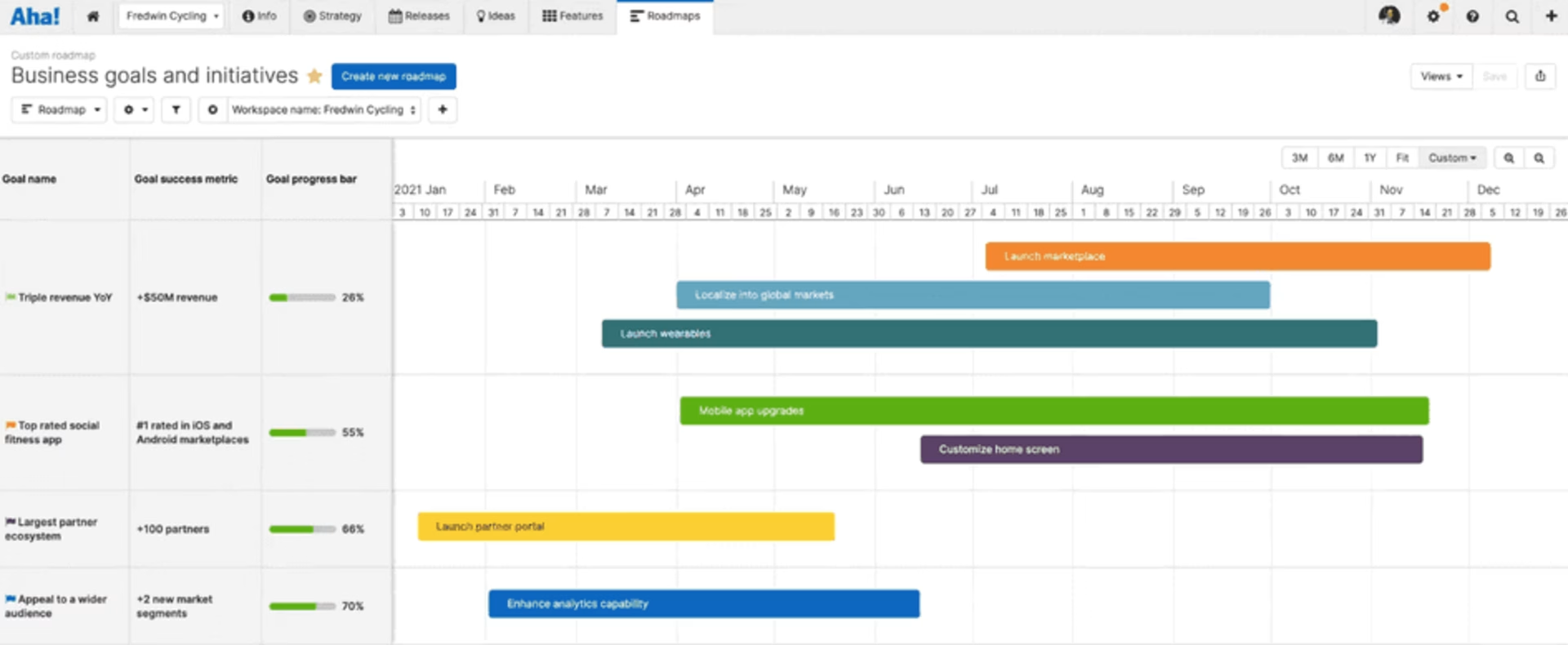When done right, your product roadmap seamlessly aligns with your business goals and keeps the product team focused on the highest priority initiatives.
But how do you build the right product roadmap for your team and business? The answer is a product roadmap strategy—a methodology for building roadmaps that bridges the gap between your product vision and mission.
This guide gives you 6 steps to develop a strategy for building a simple and effective roadmap—one that shows what to build, why your team should build it, and how to prioritize your product initiatives. You'll also learn how to present your roadmap to keep your team and stakeholders aligned and deliver better products to your users faster.
The 6-step process to building a product roadmap everyone is on board with
As a product management tool, roadmaps are not inherently effective—they're only as useful as you make them. It’s up to you to create, share, and iterate on a product roadmap that will help you achieve exceptional results.

Building this type of compelling and effective product roadmap isn’t a one-day, or even a one-week task. It requires focused efforts, along with foolproof, flexible planning—and there are quite a few logistics to be taken care of. Do it right, and, in the end, you’ll be rewarded with valuable insight and direction that you won’t get from tools like your development backlog.
Follow the 6-step process below to build a product roadmap that allows you to:
Solve the right problems
Adapt to changes in the market
Stay focused on the end-user

1. Create the product strategy that defines your product roadmap
Strategic planning is an important first step in building a roadmap. You can't build a product roadmap without a well-defined product strategy—a high-level plan that outlines your product goals and how you'll achieve them.
You need to clearly articulate the business case of a given initiative or feature, so your team understands why you’re building it—which means you have to invest time in developing your strategy first.
A brilliant product strategy helps you make confident decisions to turn your product vision into reality. According to Alan Carr, Creative Director at Webpop Design, "the first step is understanding the product, what direction you wish to go, and how you will get there. Creating a product strategy helps you answer those questions, and only then can you move to the next step, execution."
Product strategy is a bridge between vision and execution. It involves laying out major areas of investment, so you can prioritize what matters most and achieve your product goals.
A specific, user-centric strategy leaves no room for ambiguity or confusion among your product team. Working on a product without a well-defined sense of direction and purpose leads to product goals that never get realized, a lowered sense of morale within a team who feels like they lack direction, and a waste of resources.
As you work on your strategy, keep product team members and exec-level stakeholders involved throughout, and especially in the inception and development stages. This will help you:
Understand your organization's broader landscape of needs and concerns, which contributes to a more robust product strategy
Engage different organizational stakeholders to get them behind your product development process and business strategy from the start
Your product roadmap should then portray your plan for accomplishing your organization’s strategic goals and initiatives. It should communicate the ‘why', ‘when', and ‘what’ of your product plans—and explain how your efforts will support the overall business.
To develop a product strategy that will guide your roadmap, you need to:
Define your product vision. What would you like your product to do, and why?
Identify your user needs. What problems are your users facing, and how can you solve them?
Perform competitor analysis. What are your competitors doing, and how can you differentiate your product from theirs?
Analyze market trends. How are customers using your existing products? What market changes should you expect?
Set goals. What does success look like? How would you measure it?
Evaluate your company's resources. What can you develop and build with the available time, money, and people resources?
Develop a timeline. How will product releases occur over time? What’s the amount of work and detail involved in a particular milestone?
Together, these elements of your product strategy will inform everything that goes on your roadmap.
💡 Pro tip: user empathy is the key to a brilliant product strategy.
The success of your product strategy depends on your ability to deeply understand and describe your customers.
As a product manager, it’s your responsibility to identify the most important problems to solve and make informed decisions on how to solve them. The quantitative and qualitative feedback you receive from your users will inform your prioritization.
Contentsquare (hi there 👋) keeps you connected with your product experience and lets you dig deeper to discover real user needs:
Zone-Based Heatmaps give you a visual overview of how users interact with an individual element, helping you spot trends and optimization opportunities
Session Replays reconstruct individual users’ journeys so you can observe how they navigate, what they click on or ignore as they browse, and whether they encounter any issues along the way
![[Visual] Session Replay - What is CSQ?](http://images.ctfassets.net/gwbpo1m641r7/3XsaMYdpHjNeBE8x4r219k/eb9e7ae1ae4a0f3c0eedb754b9d23853/Session_Replay.png?w=3840&q=100&fit=fill&fm=avif)
The Contentsquare Session Replay dashboard
2. Identify growth opportunities for your product
With your high-level strategic planning done, the groundwork is laid for what you want to deliver and when. This is an important moment—you're at the start of a thrilling journey to deliver new value to your customers. Now it's time to identify the best product initiatives to chart your path forward.
Your next step to develop a strategic product roadmap is to use the product strategy to inform the product initiatives you'll focus on—and how they'll support your product growth.
Start by understanding users' needs and expectations: what product or feature can you create or improve to make your customers' lives easier?
Identify your customers' unmet needs through user and market research—your goal should be to understand and empathize with your customers, which will help you determine the viability of a new product, feature, or initiative.
There are many ways to conduct market research; here are the three common ones:
Interviews: 1-on-1 conversations with members of your target audience help you dive deep, gain greater empathy for their experience, and follow insightful threads that can produce plenty of 'Aha!' moments.
Surveys: surveys are an easy and inexpensive way to quickly collect data. Tools like Contentsquare’s Voice of Customer help you launch surveys and reach out to potential and existing customers to ask a series of open- or closed-ended questions about what your customers think, their needs, and how they feel about your product.
Observation: studying how customers engage with your product in a natural setting without influencing each other can yield great insights about what customer experience and expectations—how, why, and what they actually use your product for.
Once you identify your customers' unmet needs and the growth opportunities to address, you can begin brainstorming ideas and initiatives to add to your roadmap.
3. Prioritize the right roadmap initiatives to achieve your product goals
A lot goes into a product roadmap—like customer ideas, feature requests, internal input, and backlogs. What gets included in your roadmap—and in what order—should be closely aligned with the strategy you’ve already defined.
Deciding what to work on first is one of your major challenges as a product manager. There are so many features and initiatives you can add to your roadmap, but there's limited time and resources—so you need to prioritize.
Product roadmap prioritization is about choosing what to build, when, and why you're building it. You’re looking for what’s most important, realistic, and urgent. The goal is to make data-backed decisions that will benefit your product and business objectives in the long-term.
This is also a good time to identify dependencies between initiatives. Anything valuable that doesn't fit on the first iteration of your product roadmap can be saved for later in your product backlog.
An effective product roadmap prioritization process garners support from stakeholders, inspires a vision in your team, and minimizes the risk of working on something that nobody—including customers—wants.
To prioritize your roadmap, you need to develop a process for generating ideas, prioritizing which ones to focus on, and getting buy-in from key stakeholders. It can look something like this:
Understand how customers use your product and its features
Collect input and feature requests from your customers
Scoreand prioritize new features and fixes objectively to validate what to work on next
Manageand share the prioritized product roadmap with internal teams, stakeholders, and customers
Note: we’ve detailed this 4-step process and more in our full guide on product roadmap prioritization. It’s a great place to start in your journey of designing a winning product roadmap.
💡 Pro tip: prioritize effectively by listening to your customers.
Feedback collection is the most effective way to prioritize product features.
Certain product features may feel innovative, and like they will yield the best results. But your customers can have different ideas about what would improve their lives—that’s why you need to listen to them.
Customer feedback surveys help you prioritize roadmap initiatives by:
Analyzing survey data to create a list of specific features your customers are asking for, then using product prioritization frameworks to rank the features based on customer needs
Using product feedback to identify areas where your product is falling short, then prioritizing features that will address those specific problems
![[Visual] AI survey report](http://images.ctfassets.net/gwbpo1m641r7/33SvScLBCg3qC7XNcyS6EP/78f8e35c77f65ff511fd5459c686cfe4/Screenshot_2025-01-10_at_16.41.35.png?w=1920&q=100&fit=fill&fm=avif)
Contentsquare’s exit intent surveys help you pinpoint problem areas
4. Set a realistic product roadmap timeline
Now that you’ve defined the ‘why’ and ’what’ for your product roadmap, it’s time to think about the ‘when'. Once your features are prioritized and sorted, you can decide which releases and features are best aligned with your strategy, and then visualize it all on a timeline.
Product roadmap timelines typically include dates to show when new products—and updates to existing ones—will launch, and where they fit on the release plan. Some product teams choose to organize release dates by product launch; others prefer to arrange them based on development capacity.
What works for you depends on factors like market trajectories, value propositions, and engineering constraints. Once you analyze and understand these factors, you can express them in your roadmap as initiatives and timelines.
Setting a timeline with specific dates helps your product development team know exactly what their responsibilities are and what the dedicated time for each project is. However, it can also lead to unrealistic expectations, adding unnecessary pressure to your work.
Joshua Chin, the Co-founder & CEO of Chronos Agency, says "hard time frames produce an unhealthy work culture, compromising product quality”. His advice is to focus instead on setting a realistic goal that can be achieved within a soft time frame, allowing for date adjustment when necessary.
Keeping your roadmaps at a high level—months or even quarters—will help you manage stakeholder expectations and help your team focus more on delivering excellent work, rather than meeting specific deadlines.
5. Set metrics to measure the success of your initiatives
A compelling product roadmap should give a clear overview of how the strategy will be translated into action, provide a timeline for product development, and put key metrics in place to measure success.
When you connect your product strategy to the success of your implementation, you can clearly trace the impact of your work.
Setting metrics for your product roadmap offers a clear, measurable benchmark to see whether the product meets key goals. These metrics are included in a product roadmap to show the critical accomplishments required to make the product vision a reality.
Not all metrics are valuable—beware of vanity metrics, which are stats that look great and make you feel good, but don't translate meaningfully to business results. An example is the number of followers you have on social media.
If you want to make sure you're not following vanity metrics, use Eric Ries' criteria for good product metrics. If your product metrics fulfill all three criteria, you're looking at the right data:
Actionable: your metrics should have a clear cause-and-effect relationship. This means you can track every action (cause) to a specific change in metrics (effect).
Accessible: everyone on your team should understand the metrics you're tracking, how to measure them, and why they matter to business goals.
Auditable: your metrics should be unbiased and consistent. Everyone on your team should look at the metrics and reach the same conclusion.
The product metrics and KPIs you define in your product roadmap help you see an even broader picture and measure your progress. Depending on the purpose of your roadmap, you may choose metrics oriented to customer needs or business needs:
Daily, weekly, or monthly active users (AU): are the initiatives you’ve prioritized addressing real customer needs?
Monthly recurring revenue (MRR): is your revenue increasing as a result of that?
Churn rate: has your product roadmap planning improved your retention rate?
Product adoption: is your public roadmap getting potential customers excited about your product’s future?
💡 Pro tip: get rich, in-depth insights with qualitative data analysis.
Qualitative data analysis helps you make sense of customer behavior—beyond the numbers and quantitative metrics—and helps teams uncover valuable insights to better understand user behavior and build better products.
Use qualitative tools and methods—like Contentsquare Net Promoter® Score survey and Feedback Collection—to understand why some visitors converted and some didn't, to learn about their common pain points, and which product features they find most useful.

Contentsquare’s VoC tools give you in-context feedback to improve your product roadmap strategy
6. Share your product roadmap with stakeholders and request feedback
When your roadmap is ready, it’s time to show it off. Create a product roadmap presentation to keep your stakeholders in the loop on progress and timing.
The product roadmap presentation aligns internal stakeholders, communicates short- and long-term development progress, and seamlessly shares the product strategy with external stakeholders. It also helps stakeholders understand why you’re developing the product and how you’ll develop it to maximize customer delight, market share, and profitability.
Product managers often need to build multiple types of product roadmaps to tell the whole story. Having multiple product roadmaps—and a variety of presentations—also allows you to be flexible so you can easily pivot and adjust views when necessary.
If you want to gain alignment from stakeholders, your product roadmap presentation should be clear and concise, so everyone understands what each element of the roadmap represents. Here are a few things to keep in mind when presenting your product roadmap strategy:
Audience. Like a product, a roadmap has target audiences, so you need to communicate different information to those groups. The audience factor will tell you the type of content to include, the content form, and how detailed it should be.
Context. This is one of the most important things to remember when sharing and presenting your roadmap. Consider the following questions to help you decide what to include:
Who needs to see this product roadmap?
What is the most important information I want to convey?
Why is this information relevant to my audience?
Does my audience care more about the big picture or details?
Does my audience need to know general timing or exact dates?
Review. Chances are your product roadmap isn't perfect. And, that's okay—it’s all part of the roadmapping process. You can safeguard your roadmap by reviewing it every time you experience a problem, and fine-tuning it to ensure your product comes out exactly as you envisioned it.
Update. Your product progress will bring new features and goals, and your team will continuously learn about your users and product as they evolve. To keep track of changes and keep stakeholders in the loop, a product roadmap should be constantly updated.
Feedback. Always leave room for questions and feedback on your product roadmap presentation. Your stakeholders’ insights will help you improve and have better ongoing communication around your roadmap.
💡 Pro tip: use technology to build the right product roadmap for your needs.
If you’re ready to start creating and sharing your product roadmap, consider investing in purpose-built product roadmap tools and software.
Tools like Aha! Roadmaps, Productboard, Roadmunk, or even Excel help you create, customize, and share professional product roadmaps. You can choose from a variety of templates and tailor the visual details to your needs—so you can take pride in every product roadmap you build.

A product roadmap example on Aha! Roadmaps
Next steps for an effective product roadmap strategy
Most product roadmaps include the same components, but product managers need to consider many factors to build the right kind of roadmap—like your audience, the purpose of the roadmap, level of detail, and timeline.
Developing a strategic product roadmap is only the first step in implementing your product vision. As part of the promise your roadmap makes to your team and your customers to be accountable to the most meaningful work, dive deeper into best practices and incorporate some of the best product roadmap templates into your presentation.
FAQs about product roadmap strategy
What is a product roadmap strategy?
A product roadmap strategy is a methodology for building roadmaps that explain your vision behind the product, guide the direction you take throughout development, and align the organization around short- and long-term goals for the product—and how they will be achieved.
How do you build a product roadmap?
Here are six steps to building a product roadmap:
Create your product strategy
Identify growth opportunities
Prioritize roadmap initiatives
Set a realistic timeline
Set metrics to measure success
Share with stakeholders
Who is responsible for a product roadmap?
The product manager and the product team are responsible for building, maintaining, facilitating, and sharing the roadmap. That said, the best product roadmaps involve cross-functional collaboration. Incorporate insights from as many voices as possible: a range of product team members, different organizational stakeholders, and, of course, your customers. It will help you gather diverse perspectives and get stakeholder buy-in on your product strategy from the start.

![[Visual] Contentsquare's Content Team](http://images.ctfassets.net/gwbpo1m641r7/3IVEUbRzFIoC9mf5EJ2qHY/f25ccd2131dfd63f5c63b5b92cc4ba20/Copy_of_Copy_of_BLOG-icp-8117438.jpeg?w=1920&q=100&fit=fill&fm=avif)